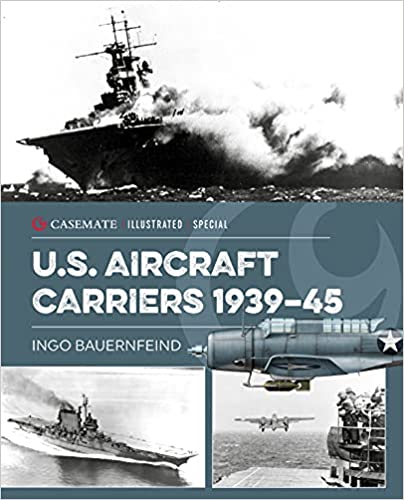Reviewed by CAPT Richard Dick, USN (Ret.)
U.S. Aircraft Carriers 1939-45 is an excellent 2021 addition to the Casemate Illustrated Specials series. This slim volume offers a surprisingly comprehensive overview of American carriers that served in World War II as well as those that belonged to wartime classes but were completed only in the aftermath of the war. Author Ingo Bauernfeind also reviews aircraft developments starting in World War I and then goes deeper in describing the development of fleet carriers and naval aircraft from USS Langley (CV-1), through the conversions of USS Lexington (CV-2) and USS Saratoga (CV-3), to interwar carrier designs. He contrasts worldwide carrier design trends, especially between the U.S. and Japan, and then sketches the carrier war in the Pacific.
The fleet carrier class histories which follow the historical overview depend on tables and well-captioned pictures to tell the stories of individual ships. Bauernfeind also sketches the design and construction of the Essex/Ticonderoga class. However, the author does not discuss the USS Midway (CV-41) and her sisters since they were not commissioned until after the Japanese surrender, arguably missing an opportunity to discuss the wartime lessons that the Navy incorporated into the Midways.
Following the fleet carriers, the author provides a ship-by-ship history of each of the light (CVL) and escort (CVE) carriers which served in World War II. This section helps the book stand out from the crowded field of aircraft carrier illustrated histories, such as Guy Robbins’ The Aircraft Carrier Story 1908-1945 and Roger Chesneau’s Aircraft Carriers of the World: 1914 to the Present. Bauernfeind reviews the development of each class of CVL and CVE (including some pointed comments on the stability problems of the CVLs) and presents a brief description accompanied by photographs for each of the nine CVLs and over 100 CVEs. Many books cover the fighting history of the CVLs and some do describe the combat histories of some of the CVEs (e.g., William T. Y’Blood’s Little Giants and Red Sun Setting). However, Bauernfeind also discusses the unheralded achievements of the CVEs providing support for Marines and Army forces and supplying replacement aircraft to replenish air groups.
After a useful overview of American carrier aircraft used in World War II, the book concludes with impressive drawings and photography of the sunken USS Saratoga (CV-3) at Bikini Atoll and a detailed photo tour of the Essex-Class museum ship Hornet (CV-12).
Interested readers can find much more detail on the fleet carriers, either by class (e.g. Alan Raven’s Essex-Class Carriers) or by individual ship (e.g. Steve Ewing’s Enterprise (CV-6): The Most-Decorated Ship of World War II- A Pictorial History). For the larger ships, Bauernfeind’s book is excellent but not exceptional. However, the coverage of the CVEs and CVLs, coupled with the book’s first-rate graphics, profuse and precisely captioned photographs, well-written text, and reasonable price make it a very good choice for readers looking for an overview of U.S. carriers in World War II.
Ingo Bauernfeind is a German film producer and author who has extensively researched, written, and produced documentaries on naval, aviation, and military historical topics in English and German. His books on warships include USS Arizona: The Enduring Legacy of a Battleship, Battleships: The War at Sea, and Prinz Eugen: Die Geschichte des legendären deutschen Kreuzers.
Captain Dick is a retired submariner and also served for over 29 years in the defense intelligence community.
U.S. Aircraft Carriers 1939-45 (Ingo Bauernfeind, Casemate Publishers, Havertown, PA, 2021).


